1950s Motoring Memories
When I was growing up in the 1950s I only knew two other children at my junior school whose parents owned a car. One was the son of a butcher whose dad had an Austin A70 Hereford followed by an Austin A90 Atlantic and the other was the daughter of a farmer who drove a Morris Oxford, the one that looked like a Minor on steroids. Quite by coincidence, my mother and the farmer’s wife had met at ante-natal classes and had become close friends so, as a young child I had the rare privilege of being treated to regular Sunday joint family excursions to the exotic seaside resorts of Bridlington, Scarborough and Whitby; stately homes like Chatsworth, Harewood and Castle Howard and a variety of North Yorkshire beauty spots including Aysgarth Falls, Fountains and Rievaulx Abbeys. I can remember us kids sitting tired and bored in the back seat with a placatory bag of crisps and a bottle of pop each while our parents visited some picturesque country pub on the way home in the evening.
At the time I was more interested in steam locomotives than cars but I do recall noticing two what are now regarded as classic cars in our small town, a Jaguar XK120 roadster owned by a local builder and a Bristol 400 saloon that belonged to the owner of the local flour mill. In those days, more exotic cars were clearly the preserve of the very rich.
With the easing of post-war austerity ordinary working class families began to aspire to car ownership and by 1959 my dad had scrimped and saved enough to buy his first car, a 1954 Austin A40 Somerset which at the time was the only car parked in our street. This curvaceous little four-door saloon with a leather interior, four-speed column gear change and steel sunroof had an asthmatic but reliable 1200cc engine that developed a meagre 40bhp giving it a 70mph top speed and leisurely ‘acceleration’ from 0-60mph that was best measured with an hourglass. It’s hard to believe that when the first 850cc Mini was introduced in 1959 with almost identical performance figures it was described in the motoring press as being ‘nippy’.
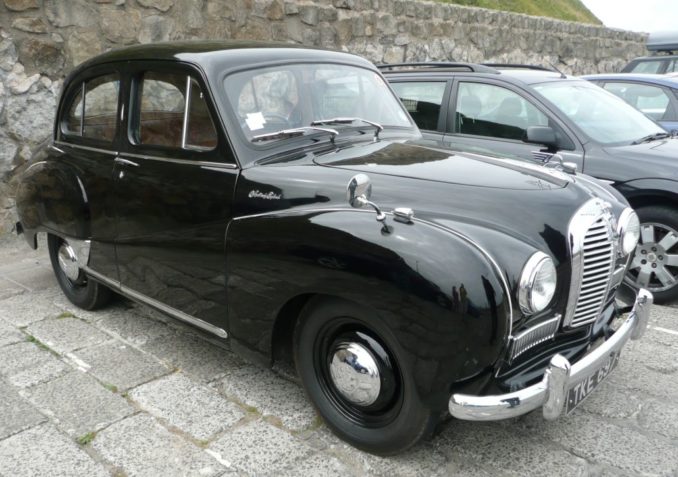
Our little A40 for all its shortcomings nevertheless opened up my horizons even further when Dad announced that for our summer holidays in 1960 we would be going to Cornwall for a week bed and breakfasting. All our family holidays up to then had been spent in our local fish and chip shop owner’s caravan at Flamborough and I still recall my excitement when our AA route booklet arrived and being given the role of official navigator. In those days if you wrote to the AA with your starting point and destination they would prepare and send you a printed booklet that unfolded to show a recommended line route annotated with pen and ink drawings of points of interest and historical notes about the towns and countryside through which you would pass. There were no motorways or city bypasses in those days and sixty years later I can’t remember much about our route other than traversing the centre of Banbury, in stop-start traffic looking out for the cross of nursery rhyme fame and learning a new word ‘undulating’ that appeared in the description of country through which we passed at some stage in the journey. We must have made a detour from the recommended route either going or coming back as one highlight for me was when we spent a spooky night in the car at Stonehenge and wandered around the stones in the early morning mist. Try doing that today. Visiting St Ives, Land’s End, Penzance and Newquay in those less-frenetic days was a delight and I left Cornwall enchanted with the county and vowing to return when I had a car of my own. This I achieved seven years later in my much loved 1962 VW Beetle 1200.
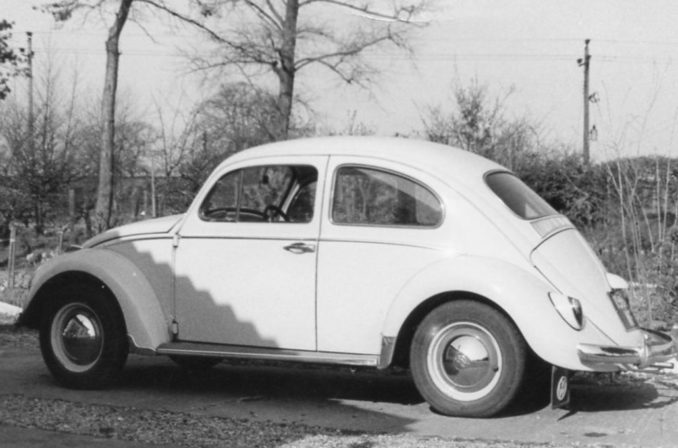
My only other experience of ‘1950s motoring’ came in 1970 when I sold a 1968 MkII Cortina 1600cc Super to buy a beautiful black and ivory1954 Riley RME 1.5 litre saloon that while being enjoyable to drive was underpowered and sadly impractical for everyday family use. I remember demisting being a particular problem with poor visibility making every winter journey into an adventure. Surprisingly for such a high quality car, a heater/demister had been an optional extra and mine had been retro-fitted with a Delaney-Gallay circular unit that sat low down in front of the gear lever with a single rheostat control that varied the speed of the feeble blower fan. It had two chrome plated doors that you opened and closed to regulate the level and direction of heat to the split screen and/or the car interior but I have no recollection of it working all that well. I only kept the Riley for a year but how I wish I still had it.
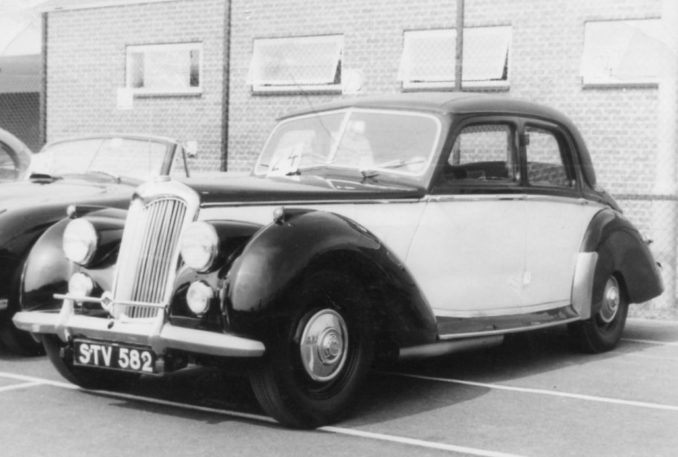
First Encounters with an MG
Some time ago when I arrived for the first time at my shooting buddy’s house in my bright red Audi A4 convertible, he casually remarked that he had a car the same colour in his garage. I didn’t know what to expect but when I saw it my eyes nearly popped out of my head, ‘Wow!’ I said, ‘A 1954 MG TF. Bloody hell, it’s beautiful.’ I don’t know who was the more surprised, I at being so close to such a stunning example of the last of the T Series MGs or its owner at my knowing both the year and model of his car without prompting.
The reason I was able to do this was that in 1968 when I’d moved to South Norfolk to begin my first job, the RDC offices were located next door to a Ford dealership that I occasionally used to look around during my lunch breaks. One day I caught sight of a beautiful ivory coloured two seater sports car at the entrance to the workshop and when I asked about it I was told that it belonged to one of our more obnoxious, land-owning councillors who was having it restored as a birthday present for the ‘friend’ with whom he shared his life and his stately home. The car was a 1954 MGTF and I was particularly attracted by the faired-in headlights that at the time gave it a more modern, sleeker appearance than its rather upright and angular predecessors.
My friend’s MG had originally been exported to California in 1954 in left-hand drive configuration and subsequently brought back to the UK by its previous owner who converted it to right hand drive and subjected it to a total, body off restoration. It took him years of hard graft to get it into its present condition which is now far better than when it first left the factory. When the owner had completed the restoration like so many hobbyist car restorers he decided to sell it at a loss to finance another project. Since acquiring the car my friend has done lots of jobs to further improve it including having a new duck hood, sidescreens and tonneau cover tailor made, changing the rear axle ratio to give more relaxed cruising and fitting electronic ignition into an original distributor body for added reliability. One job still to be done is to replace the original dynamo with an outwardly identical replacement that incorporates alternator internals as charging the battery when driving at night with the headlights on is a bit of a problem.
I left my friend’s house with a firm promise that one fine day he would bring his lovely MG round to mine and take me out for a spin in it.
The Evolution of the T Series MG Midget 1936-1955
MG TA (1936-1939)
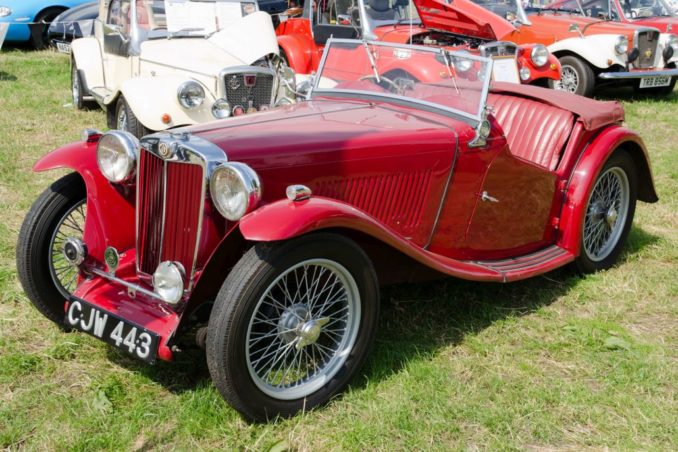
Introduced in early 1936, the TA Midget brought the prospect of sports car ownership to a much wider market of enthusiasts. With a two seater, ash framed steel body bolted to a chassis and leaf spring suspension front and rear, the TA was the first MG to have both hydraulic brakes and synchromesh on third and fourth gears. The 1292cc engine, basically that of the Morris 10 but with twin SU carburettors, produced around 50bhp which was quite an improvement on the 43bhp of the PB model that it replaced. Initially the new Midget was looked down upon by more traditional MG enthusiasts but it soon gained acceptance as it was both easy to drive and competitive. The main criticism of the TA was that its engine was not happy at high revs although aftermarket tuning equipment was eventually offered by the factory to help overcome this deficiency.
MG TB (1939)
Just prior to the outbreak of war, MG offered its new Midget that to all intents and purposes was the same as the TA apart from the XPAG series 54bhp engine taken from the new Morris 10 which had a much stronger bottom end, better valve timing and an improved cylinder head. The gearbox had modified ratios and improved synchromesh. This new model was shelved when the Abingdon MG factory like others throughout the UK went over to the production and overhaul of tanks, aircraft turrets and other military equipment.
MG TC (1945-1949)
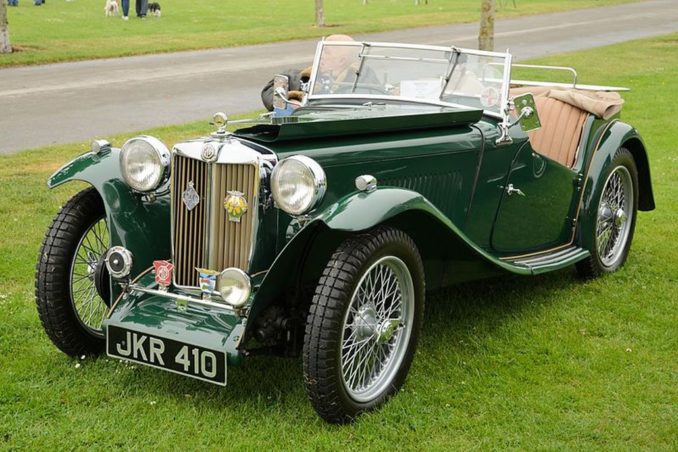
The TC is more or less identical to the TB except for changes to the rear suspension necessitated by post-war shortage of materials. To everyone’s, and not least Abingdon’s surprise, this outdated pre-war design was a great success perhaps due to the general shortage of cars being produced at the time coupled with a desire to purchase something ‘familiar’. Whatever the reason, MG realised that at a time when it was essential to the national recovery to generate foreign income, the greater their sales the greater would be their allocation of scarce raw materials. The company’s international sales drive was very effective and substantial numbers of the 10,000 TCs produced in the four years of production were exported to the USA where they generated new enthusiasm for sports car ownership and for motor sport in general.
MG TD (1949-1953)
By now the Midget was looking outdated and surprisingly the new model instead of having a sleek, modern appearance looked almost identical to its predecessors. Under the skin however, there were numerous mechanical improvements including a stronger, stiffer chassis with independent front suspension. The engine and transmission were the same as in the TC but the car now came equipped with front and rear bumpers and, to the horror of traditionalists, the spindly 19” wire wheels were replaced with 15” pressed steel wheels that looked odd on such an old-fashioned body. The new car was however more comfortable to drive than the earlier models and MG sold three times as many TDs as TCs in a similar four year production period. A Mk II version of the TD with a slightly more powerful 57bhp XPEG engine and tweaked suspension was introduced but sales declined as sports car buyers began to seek more up-to-date alternatives.
MG TF (1953-1955)
To the disappointment of many MG enthusiasts, the new TF when it finally arrived in late 1953 was not a completely new design but merely a face-lifted version of the previous TD model. A completely new MG designated EX175 had in fact been designed to succeed the TD but due to internal politics when Austin and Nuffield were merged to form the British Motor Corporation, the management did not want a new and attractive MG to dilute sales of the new Austin-Healey 100 to which BMC was already committed and so it was shelved. Most of the changes in the TF were external. The radiator grille and surround with its dummy filler cap was raked backward to give a lower bonnet line, the headlights were faired into the front wings instead of being separately mounted, the 12 gallon fuel tank was also repositioned to lower the rear of the vehicle and fitted with a rear valance and wire wheels were once again made optional at slight extra cost. More comfortable bucket seats were provided together with a map reading light and self-cancelling direction indicators operated by a dashboard mounted switch. Unfortunately, performance was identical to that of the TD and consequently sales were low. By 1955 the TF was widely considered to be a bit of a commercial flop and in a desperate attempt to boost sales BMC fitted the car with a slightly uprated 1466cc XPEG engine designating the car the TF 1500. Sadly, the writing was on the wall for the T series MG and in September 1955 the completely new, monocoque bodied MGA was announced. The T series of cars had served MG well but it was now time to move on.
Impressions of the MG TF Midget
It might have taken three years to arrange but, true to his word, my friend and his wife both dressed like characters from ‘The Wind in the Willows’ came to visit in their MG on what turned out to be the last good day of the summer. It had taken me 52 years to experience at first hand a traditional British two seater and I confess to being excited and determined to enjoy the occasion. The problem is though that the more one looks forward to something, the greater the chance of being disappointed and I was quite prepared to have some long-cherished illusions shattered.


My first impression was one of personal vulnerability. The small, cutaway, front-opening ‘suicide’ doors make getting in and out a bit of a struggle for a big bloke like me and once in I was conscious of my proximity to the steel dashboard with its prominent, chromed grab handle that could do untold damage to one’s physiognomy in the event of a prang although the padded roll across the top of the dashboard would offer some protection. There are of course no seat belts, air bags or computer-designed crumple zones to protect the occupants.
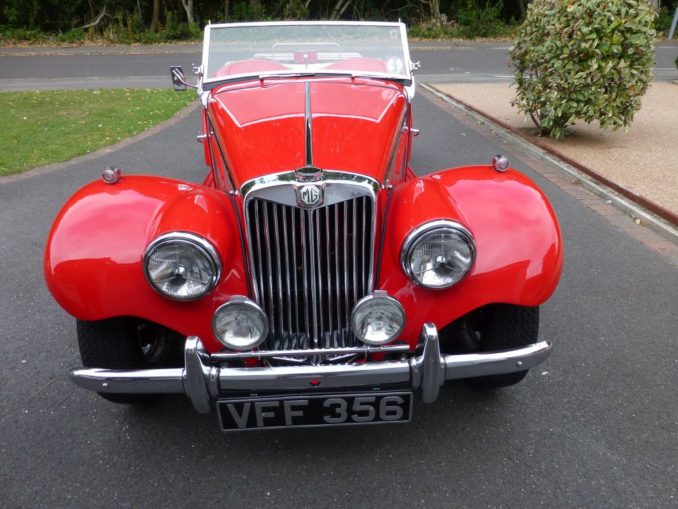
The engine started with a roar and soon settled down to a lovely burbling tickover before the fly-off handbrake was released and we set off for a short run into the New Forest to put the TF through its paces. On paper, the car with its little 1250cc engine is no ball of fire but so far as I was concerned its performance felt surprisingly brisk. Maybe it was the buffeting by the wind and the exhilarating noise of the exhaust but the impression was that the little car was quite lively and would be great fun to drive on winding country roads. As we approached a T-junction and with my right foot pressing futilely down into the passenger’s footwell, I expressed some concern regarding our ability to stop. At this my friend demonstrated the power of the brakes which practically stood the car on its nose so I needn’t have worried. Having expected a harsh and bumpy ride, I was pleasantly surprised by the smooth and supple suspension of the TF which coupled with the supportive bucket seats made for a very comfortable journey that would I’m sure be perfectly acceptable over quite long distances.

I had expected wind-buffeting around the windscreen to be a problem but with the sidescreens in place, it was noticeable but never really intrusive. A heater was an optional factory extra or after-market accessory in 1954 but none has so far been fitted. The heat through the firewall from the engine and exhaust was noticeable though and no doubt this would help in cold weather. I would imagine that demisting, as in my old Riley of similar vintage would be a problem though.
We didn’t put the hood up but I’m told it is not the easiest of tasks and takes around 15 minutes or so to do properly so it is best undertaken at the merest hint of rain if the driver wishes to avoid a potential soaking. Another problem is luggage space of which there is effectively none, hence the accessory stainless steel rack fitted to the rear of the car.
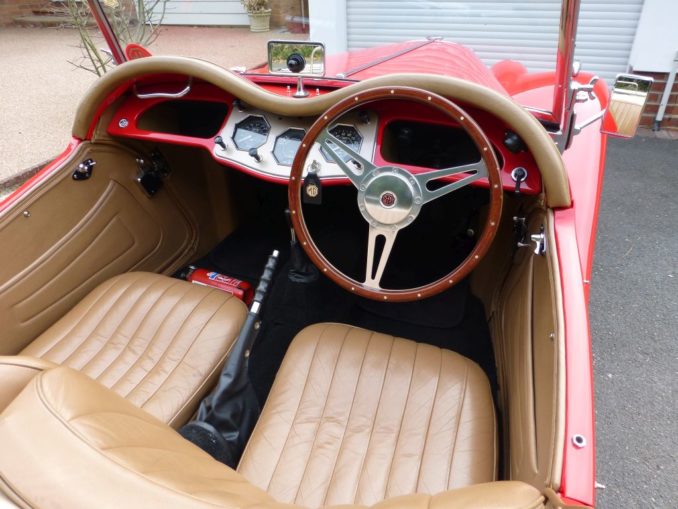
I loved the view over the long bonnet and the symmetrical dashboard with its array of octagonal instruments which surprisingly does not include a fuel gauge. Instead there is a warning light that illuminates when approximately 2.5 gallons remain in the tank but as this light is dim and a bit difficult to see in certain conditions, its current owner has fitted a supplementary warning buzzer. He also carries a dipstick behind the seats for a more accurate assessment of the fuel tank contents. The windscreen folds flat so that enthusiasts can acquire that authentic flies-in-the-teeth look but the mechanism is not as straightforward to use as on the earlier T series cars.
Top speed is somewhere in the region of 80mph (the Triumph TR2 released at the same time would do 105mph) but 55-60mph is a more realistic and relaxed cruising speed that nevertheless still feels lively.
In Conclusion
Having now experienced a T series MG for myself albeit as a passenger, it is easy to understand why so many wartime US servicemen fell in love with them and why they were so keen to ship them home when their tours of duty came to an end.
Not only did I thoroughly enjoy my first jaunt in a 1950s sports car, I was surprised by just how pleasant and refined it was. The ride was far more comfortable than I had expected and the performance felt subjectively quite brisk, the impression of speed being evident even if the speedometer told a different story. The car felt solid and nothing rattled, vibrated or fell off. The TF Midget might not be everyone’s idea of a performance car but all in all I was very impressed by this outstanding example and I would dearly love to have one of my own sitting in the garage to play with on dry days when the sun comes out.
Driving or riding as a passenger in a 1950s car on today’s roads brings home how far motoring has progressed during our lifetime, particularly with regard to comfort and safety but at the same time it highlights just how much we have lost in the sense of involvement brought about by true seat-of-the-pants motoring and the need to understand how cars work and have the ability to carry out roadside repairs oneself. Today’s cars isolate us from the world outside our personal climate-controlled cocoons and it is all too easy to forget how enjoyable driving could be in a bygone age with the wind in your hair and the smells of the countryside in your nostrils.
Sadly those days are now gone never to return.
© text & images (except where indicated) Tom Pudding 2020
The Goodnight Vienna Audio file



